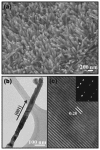Integration of metal oxide nanowires in flexible gas sensing devices
- PMID: 23955436
- PMCID: PMC3812622
- DOI: 10.3390/s130810659
Integration of metal oxide nanowires in flexible gas sensing devices
Abstract
Metal oxide nanowires are very promising active materials for different applications, especially in the field of gas sensors. Advances in fabrication technologies now allow the preparation of nanowires on flexible substrates, expanding the potential market of the resulting sensors. The critical steps for the large-scale preparation of reliable sensing devices are the elimination of high temperatures processes and the stretchability of the entire final device, including the active material. Direct growth on flexible substrates and post-growth procedures have been successfully used for the preparation of gas sensors. The paper will summarize the procedures used for the preparation of flexible and wearable gas sensors prototypes with an overlook of the challenges and the future perspectives concerning this field.
Figures





Similar articles
-
Rational design of sub-parts per million specific gas sensors array based on metal nanoparticles decorated nanowire enhancement-mode transistors.Nano Lett. 2013 Jul 10;13(7):3287-92. doi: 10.1021/nl401498t. Epub 2013 Jun 27. Nano Lett. 2013. PMID: 23796312
-
Gas sensors based on semiconducting nanowire field-effect transistors.Sensors (Basel). 2014 Sep 17;14(9):17406-29. doi: 10.3390/s140917406. Sensors (Basel). 2014. PMID: 25232915 Free PMC article. Review.
-
Solution-Processed Large-Area Nanocrystal Arrays of Metal-Organic Frameworks as Wearable, Ultrasensitive, Electronic Skin for Health Monitoring.Small. 2015 Jul 15;11(27):3351-6. doi: 10.1002/smll.201402890. Epub 2015 Mar 11. Small. 2015. PMID: 25760306
-
Polyethylene glycol-directed SnO2 nanowires for enhanced gas-sensing properties.Nanoscale. 2011 Apr;3(4):1802-6. doi: 10.1039/c0nr00843e. Epub 2011 Feb 26. Nanoscale. 2011. PMID: 21359304
-
Metal oxide nanoarchitectures for environmental sensing.J Nanosci Nanotechnol. 2003 Aug;3(4):277-93. doi: 10.1166/jnn.2003.158. J Nanosci Nanotechnol. 2003. PMID: 14598441 Review.
Cited by
-
Development and integration of a solar powered unmanned aerial vehicle and a wireless sensor network to monitor greenhouse gases.Sensors (Basel). 2015 Feb 11;15(2):4072-96. doi: 10.3390/s150204072. Sensors (Basel). 2015. PMID: 25679312 Free PMC article.
-
Solid-State Method Synthesis of SnO₂-Decorated g-C₃N₄ Nanocomposites with Enhanced Gas-Sensing Property to Ethanol.Materials (Basel). 2017 May 31;10(6):604. doi: 10.3390/ma10060604. Materials (Basel). 2017. PMID: 28772960 Free PMC article.
-
The Zn12O12 cluster-assembled nanowires as a highly sensitive and selective gas sensor for NO and NO2.Sci Rep. 2017 Dec 13;7(1):17505. doi: 10.1038/s41598-017-17673-8. Sci Rep. 2017. PMID: 29235489 Free PMC article.
-
Ultraviolet Light-Assisted Copper Oxide Nanowires Hydrogen Gas Sensor.Nanoscale Res Lett. 2018 May 15;13(1):150. doi: 10.1186/s11671-018-2566-6. Nanoscale Res Lett. 2018. PMID: 29766297 Free PMC article.
-
One-Dimensional Nanostructured Oxide Chemoresistive Sensors.Langmuir. 2020 Jun 16;36(23):6326-6344. doi: 10.1021/acs.langmuir.0c00701. Epub 2020 Jun 7. Langmuir. 2020. PMID: 32453573 Free PMC article.
References
-
- Wagner R.S., Ellis W.C. Vapor-liquid-solid mechanism of single crystal growth. Appl. Phys. Lett. 1964;4:89–90.
-
- Yazawa M., Koguchi M., Muto A., Hiruma K. Semiconductor nanowhiskers. Adv. Mater. 1993;5:577–580.
-
- Dai H., Wong E.W., Lu Y.Z., Fan S., Lieber C.M. Synthesis and characterization of carbide nanorods. Nature. 1995;375:769–772.
-
- Lieber C.M., Yang P. High-temperature superconductors. Science. 1997;277:1909–1914.
-
- Xia Y., Yang P., Sun Y., Wu Y., Mayers B., Gates B., Yin Y., Kim F., Yan H. One-dimensional nanostructures: Synthesis, characterization, and applications. Adv. Mater. 2003;15:353–389.
Publication types
MeSH terms
Substances
LinkOut - more resources
Full Text Sources
Other Literature Sources

